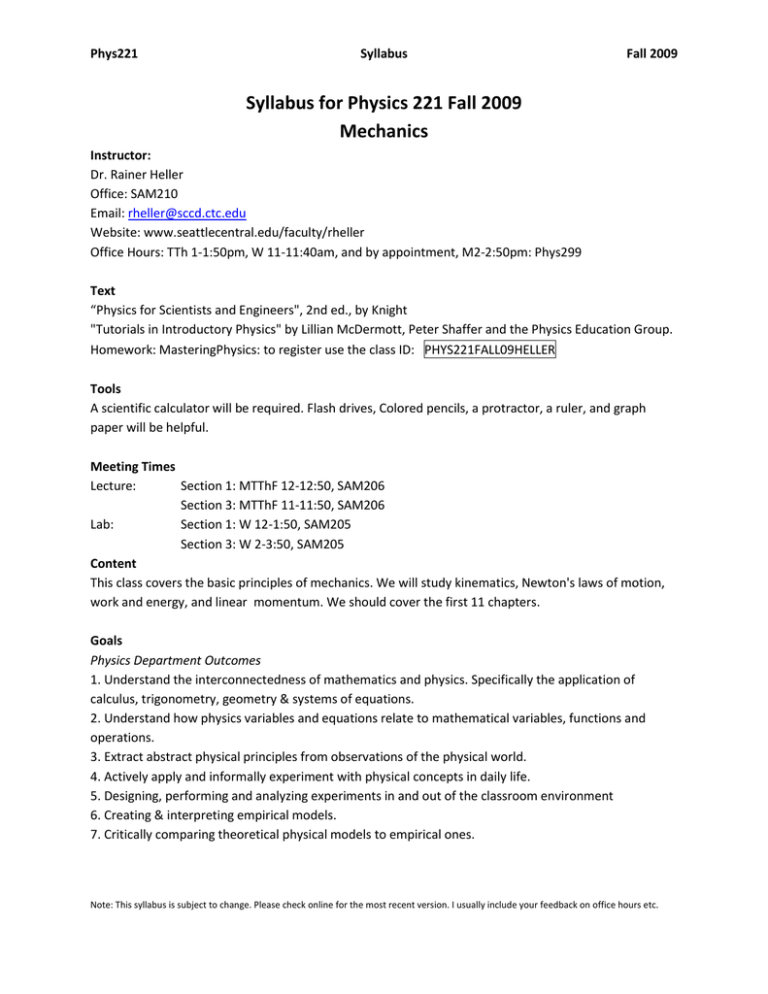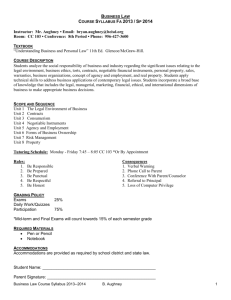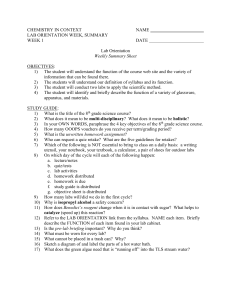Syllabus for Physics 221 Fall 2009 Mechanics
advertisement

Phys221 Syllabus Fall 2009 Syllabus for Physics 221 Fall 2009 Mechanics Instructor: Dr. Rainer Heller Office: SAM210 Email: rheller@sccd.ctc.edu Website: www.seattlecentral.edu/faculty/rheller Office Hours: TTh 1-1:50pm, W 11-11:40am, and by appointment, M2-2:50pm: Phys299 Text “Physics for Scientists and Engineers", 2nd ed., by Knight "Tutorials in Introductory Physics" by Lillian McDermott, Peter Shaffer and the Physics Education Group. Homework: MasteringPhysics: to register use the class ID: PHYS221FALL09HELLER Tools A scientific calculator will be required. Flash drives, Colored pencils, a protractor, a ruler, and graph paper will be helpful. Meeting Times Lecture: Section 1: MTThF 12-12:50, SAM206 Section 3: MTThF 11-11:50, SAM206 Lab: Section 1: W 12-1:50, SAM205 Section 3: W 2-3:50, SAM205 Content This class covers the basic principles of mechanics. We will study kinematics, Newton's laws of motion, work and energy, and linear momentum. We should cover the first 11 chapters. Goals Physics Department Outcomes 1. Understand the interconnectedness of mathematics and physics. Specifically the application of calculus, trigonometry, geometry & systems of equations. 2. Understand how physics variables and equations relate to mathematical variables, functions and operations. 3. Extract abstract physical principles from observations of the physical world. 4. Actively apply and informally experiment with physical concepts in daily life. 5. Designing, performing and analyzing experiments in and out of the classroom environment 6. Creating & interpreting empirical models. 7. Critically comparing theoretical physical models to empirical ones. Note: This syllabus is subject to change. Please check online for the most recent version. I usually include your feedback on office hours etc. Phys221 Syllabus Fall 2009 Outcomes for Physics 221 1. Understanding kinematics in one and two dimensions. . 2. Learning how to visualize and graphically represent motion. 3. Understanding dynamics in one and two dimensions; understanding Newton's laws of motion and applying them to a variety of problems. 4. Becoming familiar with vectors and their use and usefulness in physics. 5. Understanding circular motion, kinematics and dynamics. 6. Understanding impulse and momentum, work and energy. 7. Understanding conservation laws: momentum and energy. Applying them in problem solving. Assessment Exams: 70%. Lab write ups: 18-20% Homework: 10% Reading Quizzes: 0-2% Exams There will about 5 exams (i.e. about every other week), typically one for every other chapter. I may not grade all of the exams. I may only grade parts of an exam. This is unlikely but possible. Dates will be given as we progress through the quarter. There won't be any makeup exams, the lowest exam score will be dropped. There will not be any special final exam. Labs There will be weekly 2 hour labs. During this time, we will conduct an experiment, do a tutorial or go over problems together on the board. Lab reports must typically be turned in at the end of the week following the lab, specific dates and times will be given in class and/or on the website. I will give you details about what to turn in for each experimental lab. The lowest score on your lab write-ups will be dropped. Lab report drafts are strongly encouraged. These help you do your work efficiently and more effectively. You must turn in your draft on the Monday following the lab. Homework Homework will be assigned several times a week. The problem sets will be available on the class website. For this course we will use a combination of MasteringPhysics (which will allow you to submit your homework online) and problems from the purple workbook that comes with your textbook (to be turned in at the end of class). Solutions will be posted on the website shortly after the due date. Start working on your homework assignments as soon as we have covered the material in class. This will allow you to ask questions and work on difficult problems with others. I strongly recommend that you discuss problems with your classmates, however, your final work has to be your own, not a copy of somebody else’s work. Note: This syllabus is subject to change. Please check online for the most recent version. I usually include your feedback on office hours etc. Phys221 Syllabus Fall 2009 Note that late homework may not be accepted. If it is, there may be a deduction. If you have trouble finishing your work on time please let me know ahead of time, not after the due date. Phys299 You are strongly encouraged to sign up for Phys299. In this class we will meet once a week for an hour to work on homework problems or go over class material that you were struggling with. Phys299 will be held on Mondays (2-2:50pm). Special Assistance If you need course adaptations because of a disability, if you have emergency medical information to share with me, or if you need special arrangements in case the building must be evacuated, please see me during my office hours as soon as possible. I am happy to help you in any way I possibly can. How to Succeed in Physics 221 1. Attend class every day. If you miss class be sure to find out what you may have missed. Do not assume that the schedule will not change. 2. Read your text. Your text is very well written (for a physics text). Plan 3 pages/hour to really understand what is being said. Read with a pencil – do sample problems, summarize sections, etc. 3. Do your homework regularly and as soon as possible. You must practice daily in order to allow your mind time to absorb and organize the physics we are studying. 4. Hand in drafts of your lab reports. Students who take advantage of this service consistently score 10+ % higher on their labs. 5. Collaborate but don’t hide behind others. While working and studying in groups is encouraged, make sure to spend time on your own organizing your work or rewriting your homework or labs in your own words. 6. Ask for help as soon as you need it. Do not wait until you are really behind or confused. Feel free to drop by during office hours or email me with your questions. 7. Physics 299 meets weekly. Consider enrolling in this problem solving course for physics students. Even if you are not enrolled in the class you are welcome to come to get help with your work. Also utilize the tutoring center. 8. If you have a personal/family emergency that is affecting your ability to work in or attend the class be sure to contact me as soon as possible so that we can discuss appropriate accommodations to help you to succeed in the class. And let’s not forget … … to have fun Note: This syllabus is subject to change. Please check online for the most recent version. I usually include your feedback on office hours etc.






